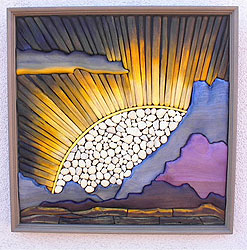
At first glance, the surfaces of Ed Hill’s freeform sculpted vessels look like mosaics, but instead of using ceramic tiles, he crafts the self-supporting structures using thin slices of wood trapped in a matrix of tinted polyester resin. With these building blocks, Hill creates an eclectic array of forms, most of which are hollow vessels. They range in size from a tiny five-inch teapot, crafted of slices of lavender wood in lavender resin, to a giraffe-like vase stretching eight feet from tip to base. As for style, that’s bounded only by Hill’s imagination.
“I get a lot of questions concerning how and why I make these things,” Hill confided to me. “The ‘why’ is simple. I get as much out of constructing it and working out the problems as I get monetary rewards.” The ‘how’ is a bit more complicated, and to help answer that question, he is currently working on a book that will describe the process by following one vessel through all its production steps.
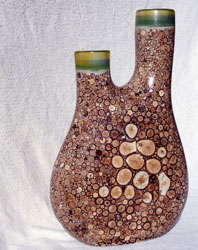
Hill starts by creating a core, usually of Styrofoam”, though occasionally balloons or even constructed wood frames. He coats the core with a mold release agent, then casts a fiberglass shell over it. The process is similar to that used for making fiberglass boats. Once the hard shell is formed, he fastens wood pieces or slices to the surface, using polyester resin to hold them in place and fill the spaces between. Often, he’ll add color to the resin for visual effects. Once the resin is set, he smoothes or textures the exterior before removing the Styrofoam.
“I don’t chop down or kill anything,” Hill told me with understandable pride. “I use locally collected desert woods exclusively, including yucca, mesquite, palo verde, saguaro ribs, cholla cactus, lilac and others. I have friends that are constantly bringing me dead wood and plant matter. In fact, one of the biggest problems I have is where to store it all.” He’ll also use wood from dead trees that are not indigenous, but have been brought into the area for landscaping.
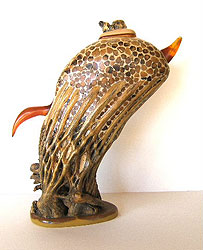
When he’s ready to build, he slices up the various pieces on a band saw to uniform thickness, then sets them in place on the form. “I use an angle grinder with a flap wheel on it for the first rough shaping,” he explained. “When they are finished, the walls of the vessels are typically a quarter to half an inch, depending on the size of the piece. People love to touch these vessels, and often ask ‘can we feel that?’ They are often mystified as to how I can so carefully place all those little segments.” While he colors the resin, he typically leaves the wood natural save for a coat or two of Danish oil. The colors come from the woods themselves, such as the rich yellow on a vessel made of grapefruit wood.
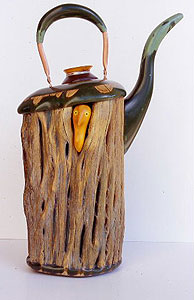
Hill, who recently turned 73, says he has always done woodworking, even as far back as high school, but it was usually for more practical reasons. “I’d make furniture or whatever else was needed around our home,” he told me. The vessels, a more recent indulgence, are part of his second career. “I retired in 1998,” Ed said, “and adopted woodworking as a full-time profession.”
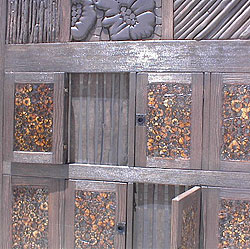
His first career was in education. Born in a small cow town in Montana, Ed went to Eastern Washington University on a basketball scholarship, but graduated with a degree in industrial arts education. For a while, he taught school in Montana and Washington, then went back to school at Washington State University to get a master’s and doctorate in industrial arts education. Eventually, he became a curriculum developer for that university, spending most of his working life in either teaching or administrative work before moving to Arizona.
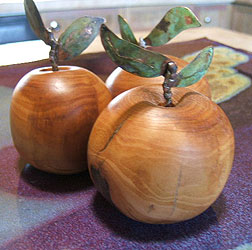
Along with the vessels, he and his wife, artist JoAnn Hill, create a line of panels and doors with cut, applied and painted segments. They also spend a good bit of time in community service. “My wife and I are both involved in rebuilding Summerhaven,” Ed explained, “a village that burned down in a month-long fire that consumed 85,000 acres of Arizona in 2003. There’s a committee trying to preserve a 100-year-old apple tree that managed to survive the fire.” To support that effort, Ed and JoAnn are making wooden apples from some of the fallen wood from that tree. The apples will be auctioned off during the group’s gala fundraising ball.
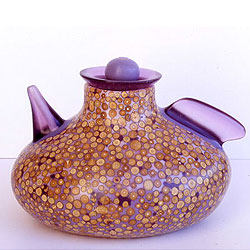
Mostly, though, Ed spends his time appreciating what wood has to offer. “It is fascinating to see what can be exposed in a piece of wood that does not initially look like much,” Ed explained. “Working with it is so rewarding and enriching: to do something with your hands, and come up with something people appreciate. I am just in love with wood and enjoy being a partner with Mother Nature to create patterns with wood.”







